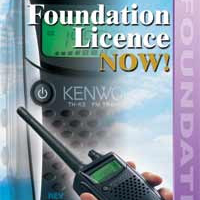Years ago, anyone interested in becoming a radio amateur was required to take complex tests involving electronics theory, radio construction and in most cases, learn Morse code. Things have changed here in the UK, making it considerably easier for newcomers to get into the hobby. You can now get started with an entry-level Foundation Licence in a few weeks, or with an intensive weekend course.
The Foundation licence is the most basic of all the exams and will give you basic insight into the hobby and get you on-air. Holding a Foundation licence will give you access to the full Amateur Radio frequencies with a power limit of 10 watts, increasing as you pass your Intemediate and Full licence examinations.
The Foundation Licence Now book is an essential part of the UK Foundation Licence. It’s a 42-page A4 book that explains all of the basics, contains handy bits of information for the newbie amateur, and tells you what you need to know to pass the exam. At the time of writing, it’s under £8 (at the time of writing) at Amazon on paper and on Kindle: Paper version and Kindle version.
Foundation: Practical
Practical assessments are required for you to pass your Foundation exam. Don’t worry, these practicals are incredibly simple and if you get stuck, a tutor will be able to show you exactly what to do. All Foundation licence holders are required to demonstrate that they can connect and use an amateur radio transmitter and antenna. The practical assessments have to be completed in front of a Registered Assessor – For us this would be Adam (MW0XDD)
Practicals include:
- Basic radio operation – Tuning in, changing frequency and transmitting
- Connecting a radio, antenna and power supply
- A short transmission on a VHF/UHF amateur band
- A short transmission on an HF amateur band
- Adjusting a dipole antenna
- Sending and receiving a short phrase in Morse code (you don’t need to learn Morse)
Foundation: Exam
After completing the practical part of the course, you’re required to sit a 26-question multiple choice exam.
The questions are in the following categories:
- Amateur Radio and Licence Rules – 6 questions
- Technical Basics – 4 questions
- Transmitters & Receivers – 3 questions
- Feeders and Antennas – 3 questions
- Signal Propagation – 2 questions
- EMC (avoidance of interference) – 3 questions
- Operating Practices – 3 questions
- Safety – 2 questions
You have 60 minutes to answer the 26 questions, and if you’ve paid attention during your training, and studied the book, then the exam should present no problems at all. To pass, you’ll need to get 19 of the 26 questions correct.
Foundation Licence & Callsign
Your exam paper will be marked as soon as the exam is finished, so you’ll get an idea of whether you’ve passed before you leave the examination hall. Your results will then be sent to the RSGB (Radio Society of Great Britain) and assuming you pass, the RSGB will upodate Ofcom after 6 working days and you’ll be sent a Pass certificate by post normally the day after. Please note this may take longer depending on how busy the RSGB office is.
Once you recieve your certificate, you’ll be able to apply for your licence and callsign. To do this you will need to register an account with Ofcom Licencing Services here and apply through the site itself. Your Foundation callsign will begin with “M7” followed by three letters, and you can pick those three letters yourself (if the callsign you’re after hasn’t been taken)
Once you have your callsign and your licence, you’re able to start transmitting on HF (long distance) and VHF/UHF (shorter distances), and you can start to see where the hobby takes you.
Source: EssexHam
